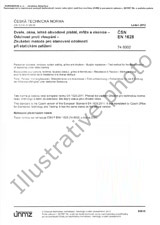We need your consent to use the individual data so that you can see information about your interests, among other things. Click "OK" to give your consent.
ČSN ETSI EN 301428-V2.1.1 (876032)
Satellite Earth Stations and Systems (SES); Harmonised Standard for Very Small Aperture Terminal (VSAT); Transmit-only, transmit/receive or receive-only satellite earth stations operating in the 11/12/14 GHz frequency bands covering the essential requirements of article 3.2 of the Directive 2014/53/EU
Translate name
STANDARD published on 1.12.2016
The information about the standard:
Designation standards: ČSN ETSI EN 301428-V2.1.1
Classification mark: 876032
Catalog number: 500833
Publication date standards: 1.12.2016
SKU: NS-668723
The number of pages: 68
Approximate weight : 204 g (0.45 lbs)
Country: Czech technical standard
Category: Technical standards ČSN
The category - similar standards:
Radio relay and fixed satellite communications systemsSatellite
Annotation of standard text ČSN ETSI EN 301428-V2.1.1 (876032):
V2.1.1
The present document applies to Very Small Aperture Terminals (VSATs) which have the following characteristics:
" The VSAT is operating in one or more frequency ranges in the part of the following bands allocated ex-clusively to the Fixed Satellite Services (FSS):
- 14,00 GHz to 14,25 GHz (earth-to-space);
- 12,50 GHz to 12,75 GHz (space-to-earth);
or in the shared parts of the following bands, allocated to the FSS and Fixed Services (FS):
- 14,25 GHz to 14,50 GHz (earth-to-space);
- 10,70 GHz to 11,70 GHz (space-to-earth).
- " The VSAT uses linear polarization.
- " The VSAT operates through a geostationary satellite at least 3° away from any other geostationary sat-ellite operating in the same frequency band and covering the same area.
- " The VSAT antenna diameter does not exceed 3,8 m, or equivalent effective area.
" The VSAT is either:
- a transmit only VSAT: designed for transmission only of radio-communications signals in any of the fre-quency bands (earth-to-space) specified above; or
- a transmit and receive VSAT: designed for transmission and reception of radio-communications signals in any of the frequency bands specified above; or
- a receive only VSAT: designed for reception only of radio-communications signals in any of the frequency bands (space-earth) specified above.
- " The VSAT is designed usually for unattended operation.
- " The VSAT is operating as part of a satellite network (e.g. star, mesh or point-to-point) used for the dis-tribution and/or exchange of information between users.
- " The transmit only and transmit and receive VSAT is controlled and monitored by a Centralized Control and Monitoring Function (CCMF). The CCMF is outside the scope of the present document.
The present document applies to the VSAT with its ancillary equipment and its various terrestrial ports, and when operated within the boundary limits of the operational environmental profile declared by the applicant and when installed as required by the applicant by declaration or in the user documentation.
The present document is intended to cover the provisions of Directive 2014/53/EU [4] (RE Directive) article 3.2, which states that ". radio equipment shall be so constructed that it both effectively uses and supports the effi-cient use of spectrum in order to avoid harmful interference".
In addition to the present document, other ENs that specify technical requirements in respect of essential re-quirements under other parts of article 3 of the Directive 2014/53/EU (RE Directive) [4] may apply to equipment within the scope of the present document.
NOTE: A list of such ENs is included on the web site
Preview of the standard ČSN ETSI EN 301428-V2.1.1 (876032)
We recommend:
Technical standards updating
Do you want to make sure you use only the valid technical standards?
We can offer you a solution which will provide you a monthly overview concerning the updating of standards which you use.
Would you like to know more? Look at this page.




 Cookies
Cookies
